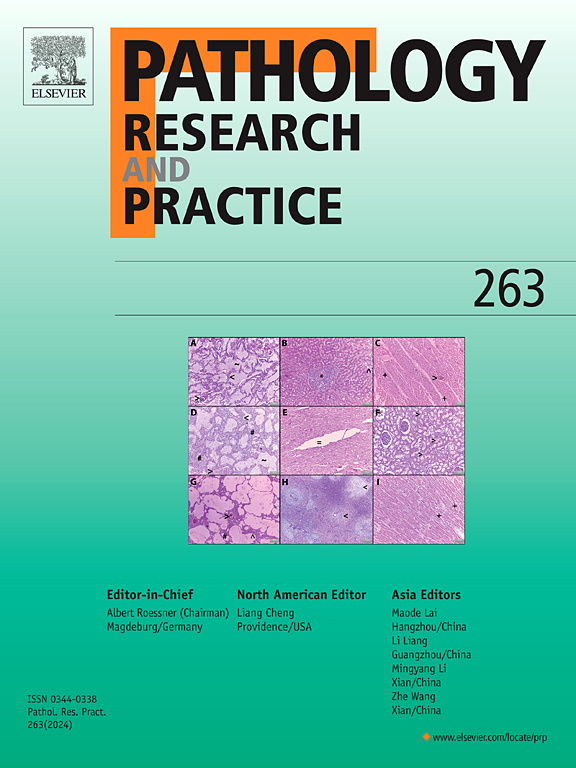EMC8 expression in head and neck squamous cell carcinoma: Implications for poor prognosis and deficient CD8+ T cell infiltration
IF 3.2
4区 医学
Q2 PATHOLOGY
引用次数: 0
Abstract
Emerging evidence highlights the role of Endoplasmic Reticulum Membrane Protein Complex (EMC) subunits in tumorigenesis, yet the function of EMC8 (Endoplasmic Reticulum Membrane Protein Complex Subunit 8) in Head and Neck Squamous Cell Carcinoma (HNSCC) remains elusive. In this study, we found EMC8 is significantly upregulated in HNSCC tissues compared to adjacent normal tissues, at both mRNA and protein levels. Kaplan-Meier survival analyses demonstrated that high EMC8 expression is associated with poorer overall survival, disease-specific survival, and progression-free interval in HNSCC patients. Further exploration into the tumor microenvironment showed that EMC8 expression negatively correlates with the infiltration of multiple immune cells, particularly CD8 + T cells, which was validated in clinical samples where high EMC8 expression corresponded to reduced CD8 + T cell infiltration. Additionally, single-cell RNA sequencing data indicated that EMC8 expression is positively associated with dedifferentiation, hypoxia, and stemness properties of HNSCC cells. Collectively, EMC8 upregulation in HNSCC correlates with poor prognosis, reduced CD8 + T cell infiltration, and aggressive phenotypes, positioning it as a potential prognostic marker with mechanistic links to immune evasion and malignancy warranting deeper exploration.
EMC8在头颈部鳞状细胞癌中的表达:与预后不良和CD8+ T细胞浸润不足的关系
新出现的证据强调了内质网膜蛋白复合物(EMC)亚基在肿瘤发生中的作用,但EMC8(内质网膜蛋白复合物亚基8)在头颈部鳞状细胞癌(HNSCC)中的功能仍然难以捉摸。在本研究中,我们发现,与邻近的正常组织相比,EMC8在HNSCC组织中的mRNA和蛋白水平均显著上调。Kaplan-Meier生存分析表明,高EMC8表达与HNSCC患者较差的总生存期、疾病特异性生存期和无进展期相关。对肿瘤微环境的进一步探索表明,EMC8表达与多种免疫细胞的浸润呈负相关,尤其是CD8 + T细胞,这在临床样品中得到了验证,EMC8高表达与CD8 + T细胞浸润减少相对应。此外,单细胞RNA测序数据表明,EMC8的表达与HNSCC细胞的去分化、缺氧和干性呈正相关。总的来说,EMC8在HNSCC中的上调与预后不良、CD8 + T细胞浸润减少和侵袭性表型相关,将其定位为与免疫逃避和恶性肿瘤有机制联系的潜在预后标志物,值得更深入的探索。
本文章由计算机程序翻译,如有差异,请以英文原文为准。
求助全文
约1分钟内获得全文
求助全文
来源期刊
CiteScore
5.00
自引率
3.60%
发文量
405
审稿时长
24 days
期刊介绍:
Pathology, Research and Practice provides accessible coverage of the most recent developments across the entire field of pathology: Reviews focus on recent progress in pathology, while Comments look at interesting current problems and at hypotheses for future developments in pathology. Original Papers present novel findings on all aspects of general, anatomic and molecular pathology. Rapid Communications inform readers on preliminary findings that may be relevant for further studies and need to be communicated quickly. Teaching Cases look at new aspects or special diagnostic problems of diseases and at case reports relevant for the pathologist''s practice.

 求助内容:
求助内容: 应助结果提醒方式:
应助结果提醒方式:


